 Dislikes: 0
-
The Secret to Removing Oxidation and Restoring a Show Car Finish to Antique Single Stage Paints
The Secret to Removing Oxidation and Restoring a Show Car Finish to Antique Single Stage Paints
Restoring original and antique paint
In the collector car hobby world, there’s a lot of interest in restoring and preserving original paint on classic and antique cars. Restoring the original paint maintains the overall originality of the complete car and adds to the value as long as the resulting finish is acceptable in appearance and represents how the vehicle would look for its age had the paint been properly maintained over the years.
Hard as it is to believe, people are still finding old cars in barns, storage buildings and garages across this great land and with the right products, techniques and a little knowledge of what to do and what not to do, it’s possible to restore a show room new finish to these time capsule treasures.
What to do
If preserving the original paint is important to you then the first thing you want to do is condition the paint before working on it. Most people just jump right in and start rubbing some type of abrasive compound over old, dry, fragile paint and this will remove a lot of paint quickly and possible remove too much. Instead, take the extra step of conditioning the paint and bring it back to life with product that's been around since cars and thus car paints have been around.
Below I will share the product and actually a technique that may restore your car's paint to your expectations without using any abrasives at all. In the car detailing world we're always talking about the idea of,
"Use the least aggressive product to get the job done"
In this article I'll show you at least one way to put that philosophy into practice.
What not to do
The first thing most people do when trying to restore an old, oxidized finish is reach for some rubbing compound and try to rub the dead, oxidized paint off the car. While this will work, it's the caveman approach because it's too aggressive, it will remove too much paint and because there's a better, safer approach that will provide a better chance at preserving as much of the original paint as possible which is the goal if you're trying to preserve the "originalness" of the car.
So if you're reading this and you have an old car out in the garage that has oxidized single stage paint, let me share with you a way of conditioning the paint in a non-abrasive way that will make your car's old, tired paint come back to life. Then you can either stop at that point if you like the results you're seeing and apply a coat of wax or I'll share with you how to machine polish the paint to squeeze out even a little more depth, shine and gloss.
The problems with restoring antique and original paint
- Single stage paints are prone to oxidation
- Single stage paints are thin
- Single stage paints are fragile
- Single stage paints are soft
Single Stage Paints are Prone to Oxidation
Antique and older, single stage paints are usually some type of lacquer or enamel and these paints are prone to oxidation when exposed to air and moisture over time.
Oxidation in simple terms is when the oxygen molecules in the air act to remove electrons from the paint resin. In other words the paint deteriorates by coming apart or disintegrating.
This usually shows up as a chalky whitish looking color on the surface of the paint even if the paint was originally some other color besides white. Just to note, white paint will oxidize too but because it’s the same color as the chalky white oxidization you have to look carefully to see it. Oxidized white paint can just look dull when it in fact is oxidized.
If the oxidation isn't too extreme it will merely be a topical problem that is easily fixed by simply abrading the surface to remove the oxidized or dead paint off the surface, which will expose a fresh base which you can then polish to a high gloss.
Single Stage Paint = Easy to Restore
Here's an example of mild oxidation on a yellow single stage enamel paint on a 1960 Ford Ranchero, on which I restored the paint a few years ago...

Here's what the paint looks like after the oxidation was removed and the paint was polished to a high gloss.
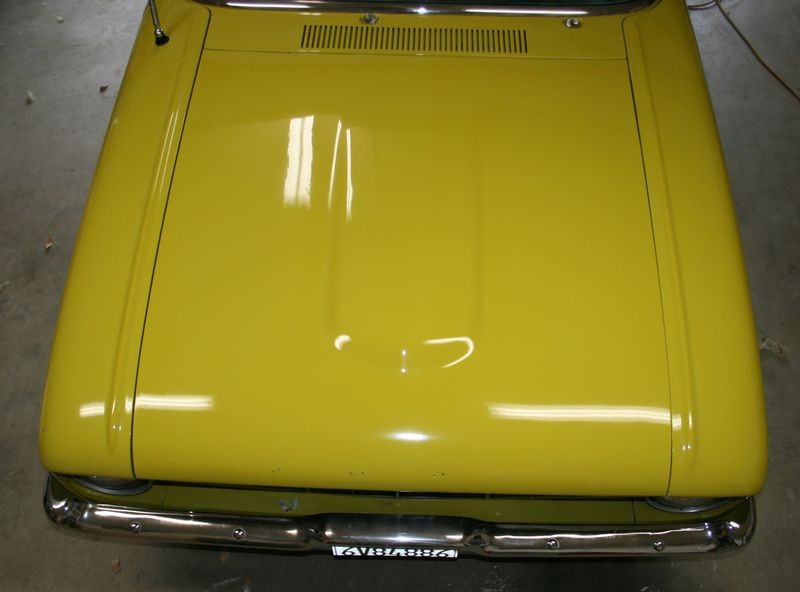
Single Stage Metallic Paint = Difficult to Restore
Single stage, non-metallic paints like the above paint on the Ranchero are actually very easy to fix because the problem is for the most part just topical, that is the problem is just on the surface. All you have to do is remove the dead paint off the surface and if there's enough paint left then it's just a matter of polishing what's left to a high gloss. The most difficult paints to restore are single stage metallic paints.
The reason single stage metallic paints are the most difficult to restore is because not only does the paint itself oxidize, that is the resin used as the binder, (generally some type of seed oil like Flaxseed oil or Cottonseed oil), but also the aluminum flakes embodied inside the paint oxidize. This is where the problem lies.
It's a problem because the entire exterior surface of each individual aluminum flake oxidizes over time but you and I can only work on the surface of the paint and thus we can only work on the portion of the flake that is exposed at the surface level. Any portion of each aluminum flake that is below the surface and is surrounded by paint cannot be cleaned or polished so there's no way to remove the oxidation on the portions of the flakes inside the paint.
Oxidized Aluminum Turns Black
With metallic single stage paints, oxidation can show up as a darkening effect on medium to light colored paints because the aluminum metal flakes embodied inside the paint will stain or discolor the paint with a grayish black color.
If you’ve ever polished uncoated aluminum then you’ve seen this grayish black color coming off the aluminum and onto your polishing cloth as you work a metal polish over it. This same type of oxidation is taking place to the aluminum flake inside the paint.
Polishing Uncoated Aluminum
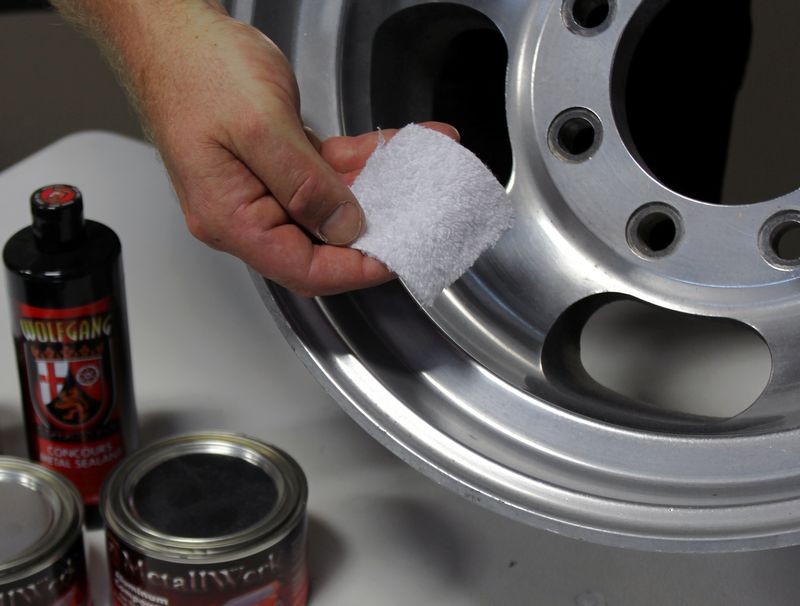

Oxidized Aluminum Comes Off Black
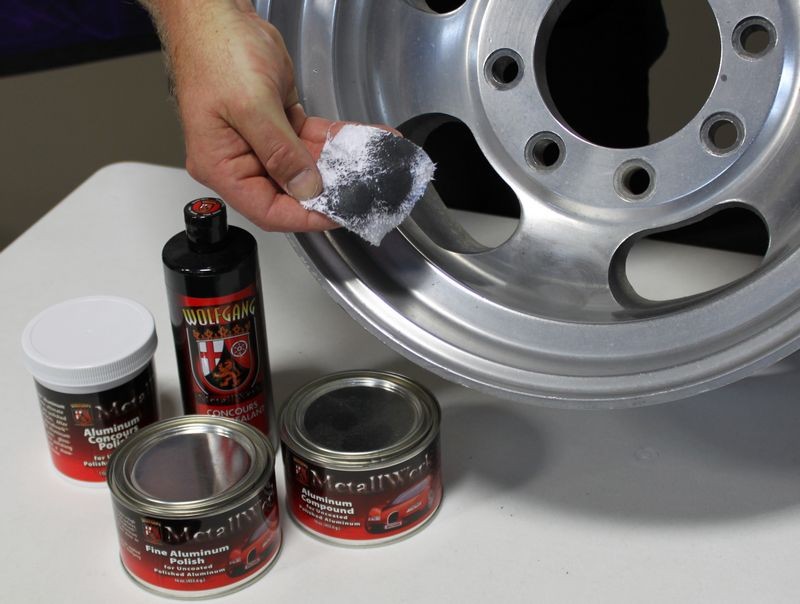
Wolfgang MetallWerk™ Aluminum Polishing System
In the same way you see the black residue coming off the aluminum wheel onto the piece of white cotton terry cloth material above, when working on metallic single stage paints you will see black residue coming off the paint and onto you applicator pads, buffing pads and wiping towels.
This darkening effect can take place even at the same time the surface of the paint itself is turning chalky white. This is because you have two different substances oxidizing, both the paint and the aluminum flake, which both are oxidizing at the same time. The paint oxidizes white and the aluminum flake oxidizes black.
Besides the oxidation issue, here are some other problems associated with restoring antique and/or old single stage paints...
Single Stage Paints are Thin
Factory paint is thin to start with, now add to this that over the years other people may have worked on the paint in some fashion and abraded some of the coating off, so not only is old factory paint thin to start with, it can potentially be thinner than when it was first sprayed just due to the fact that other people have worked on the paint before you.
This is another reason you need proceed with caution and always follow the best practice of,
"Use the least aggressive product to get the job done"
(Note I used the word aggressive, not the word abrasive, there's a difference)
The challenge when paint is thin is how to restore the paint by abrading it without destroying it at the same time because there's just not a lot film-build to work with. Words cannot describe the heart sinking feeling an owner must experience when they discover they’ve polished through the topcoat of paint and exposed primer or even worse… shiny metal!
Single Stage Paints are Fragile
Single stage paints are a lot more porous or permeable than today's modern basecoat/clearcoat paints. Liquids can penetrate more easily into them and the oils the paints are made with will more easily leach-out and as a result the paint will dry-out over time.
When the paint dries out, besides having a chalky appearance due to oxidation, it will also become fragile and weak. It will be dramatically more susceptible to attack by any corrosive or destructive liquid introduced to the surface, for example brake fluid.
Modern clear coat paints are non-porous or impermeable, that is the resin structure is more dense and oftentimes harder. Liquids cannot easily penetrate into the resin, nor will the resin, deteriorate as easily or quickly like single stage paint.
Single stage paints are soft
Generally speaking, single stage paints are soft, at least soft when compared to modern basecoat/clearcoat paints. I wrote an article about this here,
The practical differences between single stage paints and a clear coat paints
The exception to this rule, (single stage paints are soft), is when it comes to single stage white paints and this is because the type of pigment used to add color to a single stage paint can and will affect the hardness of the paint. In the case of single stage white paint, the pigment type is Titanium Dioxide Powder. Titanium Dioxide is a very hard substance in and of itself and when mixed with a paint resin it modifies the workability of the paint making it a harder coating than the resin would have been with no Titanium Dioxide added to it. Conversely, single stage black paint is the softest paint there is to work on because the pigment used to make black paint is Carbon Black, which is basically similar to the soot that builds up inside the lid of an outdoor barbecue or inside your fireplace chimney. Next time you’re around either a barbecue or a chiming, rub your finger against the lid or inner brick wall and you’ll remove a very soft, powdery substance; this is a type of Carbon Black.
Suffice to say, most single stage lacquers and enamels are soft to start with because of the raw materials used to make them, (seed oils), except if they are white. Over time as they dry out, they become softer and it’s important to know this because using anything sharp or abrasive like an archaic rubbing compound will remove a lot of paint quickly.
For more information on the topic of hardness and softness of paints, see my classic article,
The Lesson White Paint Teaches Us
(Be forewarned, this is real Tom Clancy type, sitting-on-the-edge-of-your-seat reading material)
The Problem = Abrasives are too Abrasive
The problem when restoring antique and original paints is when the person doing the work uses too aggressive of a product and chews off or abrades off too much paint too quickly, he exposes either the primer coating under the colored layer of paint, or the material that makes up the underlying panel, which is usually steel or aluminum on classic cars. Besides that, some rubbing and polishing compounds use a type of solvent as a carrying agent, that while it may work well for suspending the abrasive particles in a uniform consistency, it will tend to dry out a single stage paint, which is opposite of what you want to do when you’re trying to preserve and restore an antique paint. If you’re working on a modern clear coat then this is not a huge facto. If you’re working on a 1936 Hupmobile found with the original paint in an old farm barn you inherited, then you don’t want to use products that can scratch and dry out the paint.
All too often I've seen a well-meaning person select a very coarse, or heavy duty rubbing compound to remove the oxidation off an old car and because the paint is thin, soft and fragile because it's dried-out and old, and thus it’s easily abraded, that by the time this person can see how much paint they’ve removed they’ve already gone past the point of no return and at this point it’s game over, to quote my 11 year old son.
What you want to do is remove the oxidation safely and carefully while at the same time bringing the paint back to life by gorging it with rich polishing oils. What you don’t want to do is remove the oxidation by scouring the paint with a rubbing compound that’s similar to beach sand while at the same time you’re exposing the newly exposed fresh base or layer of paint to a harsh solvent.
Stoddard Solvent is inexpensive and a commonly used solvent for in-expensive rubbing and polishing compounds. Stoddard Solvent is commonly used in automotive parts washers; it works great for stripping grease and oil off car parts and in the same way it will dry even more, already dry paint. Avoid products with inexpensive solvents on paint that's important to you.
Here’s the good news… there is a way to safely restore antique paint using a product that as near as I can tell came out in the early 1920’s and possibly even earlier… it’s hard to find out this kind of information because anyone that would know this kind of information is no longer with us and alas nothing’s been written down over the decades…
The Secret of Number Seven
There is a way to restore single stage paints that is non-abrasive and as gentle as you can get using a product that’s been around since early paints were formulated. That product is called Meguiar's Mirror Glaze #7 Show Car Glaze.
#7 Sealer Reseal Glaze = Show Car Glaze
Here’s a photo of a few bottles of #7 from my car wax collection. I have some older bottles from before WWII, but this picture shows the transition from when the name changed from Sealer and Reseal Glaze to Show Car Glaze.

(Click here for a larger picture)
The glass bottle on the left hand side is post-WWII. You can identify glass bottles as pre-WWII or post-WWII by the name on the label. Pre-WWII bottles will say Mirror Bright on the front label and post-WWII bottles will have Mirror Glaze on the bottle. This has to so with a posterity program instigated by the U.S. Government at the start of World War II which prevented companies from raising prices on existing products; because the cost of raw materials were increasing due to the war a lot of companies couldn’t make a profit under the new regulations so to get around them they would introduce a new product line at a higher price point. These could be the same physical products but introduced as a new product line by giving the products different names.
#7 Show Car Glaze as it’s called today is what’s referred to as a non-abrasive pure polish, it’s not for abrading paint but instead for maintaining paint and creating a beautiful finish. There’s a lot of confusion over this product and any product that uses the word polish in the product's name or on the label because the word polish is usually interpreted to mean some type of abrasive product as in a rubbing or polishing compound. While that might be true for some products it’s not true for this product.
Sometimes I have to remind people that #7 has been around long before plastic was invented, thus the glass bottles. The plastic "cylinder" bottle you see below, (just to the right of the glass bottle), was the first plastic bottle used for #7 and was introduced I think in the late 1950's, maybe early 1960's.
The 4th bottle from the right shows when they changed the name from Sealer Reseal Glaze to Show Car Glaze primarily because as our lingo changed in the car appearance world. People were confusing the word "Sealer" with the word "Sealant" and M07 is water-soluble. Hopefully everyone reading this can understand why that kind of confusion could be a problem in the enthusiast or consumer market.
The third bottle from the right shows the label during the transition when the name was changed. If you look closely under the words Show Car Glaze it reads, (Same as Sealer and Reseal Glaze)
Transition Label Circa Late 1980's or 1990's

Just in case you don’t understand why there was some confusion over the use of the word "Sealer" here’s why; a paint sealant is for protection and should last through inclement weather and repeated car washings. #7 is water soluble; that means it will break down in inclement weather or with repeated washings. It offers no lasting characteristics. It’s not supposed to be a paint protectant, but a glaze that’s safe for use on fresh paint and will give paint a wet-look.
The name sealer and reseal glaze came from it's ability to hide or mask hairline scratches temporarily, or in other words it would seal hairline scratches and as it wore off and was re-applied it would reseal, or re-hide hairline scratches.
In today's detailing lingo hairline scratches = swirls.
#7 has no protection ability and no lasting ability. So when the word sealant became more commonly used in the car wax market people were confusing the word sealer with sealant and purchasing and using the product thinking it was a paint sealant that would last for a long time and protect for a long time when in fact it's nickname is Queen-For-The-Day, in that car guys would wipe their car down with #7 to give it the wet-look for the day of the big car show but the first time the car is washed the extremely wet look the product would impart to paint would disappear as the water soluble oils would wash off with the rinse water.
Anyway, the name was changed sometime in the early 1990’s as back in the 1980’s and continuing through to even today, a lot of “paint sealants" have been introduced in the car appearance market to compete along side Carnauba car waxes. So to avoid confusion the name was changed to reflect, (no pun intended), what this product is and has been famous for over the last century and that’s create a deep, wet shine on show cars.
Bringing the dead back to life...
Besides being used as described above, #7 is also famous for its ability to revive dead, oxidized single stage paints. This has to do with the unique feeder-oil formula created by Frank Meguiar’s Jr. back in the early days of Meguiar’s which was also the early days of the Automobile. Meguiar’s was founded in 1901 and for perspective, only a few years earlier in 1886, Karl Benz was awarded a patent for a gas-fueled car and it wasn’t until 1908 that Henry Ford introduced the Model T.
I don’t know exactly when #7 was introduced but I think sometime in the early 1920’s, like 1923 or 1924. While #7 may have been introduced in the 1920’s, the formula that became #7 was around even earlier, possibly back to 1901. Here's a collection of 4 very old Mirror Bright polishes; it is my opinion that the formulas used in these products were pre-cursors to what became #7 Sealer and Reseal Glaze.
Photos Courtesy of MeguiarsOnline.com

Now let me tie this back to the topic at hand…
Restoring antique single stage paints can either be done the caveman way, using an aggressive compound and risking grinding all the thin paint off the car, or it can be done the careful way, and that is FIRST conditioning the paint using the unique, time-proven rich polishing oils found in the #7 Show Car Glaze and THEN if needed, then use some type of abrasive product to abrade and polish the rejuvenated paint back to a deep, wet shine with a rich, high gloss.
The technique I will share with you in this article works great for old, oxidized single stage NON metallic paints. If that describes the paint on you car, for example you have a classic 1965 Mustang in your garage with non-metallic single stage enamel paint, then this technique will work great as long as the paint isn't past the point of no return in the first place. Restoring non-metallic paints is a cake walk.
The hardest paint related task to do in the car detailing world is to revive and restore single stage metallic paints because not only will the paint oxidize, but the aluminum metallic flakes inside the paint will oxidize and you since you can’t remove the oxidation off each individual flake inside the paint then most you can do is remove the topical oxidization and gorge the porous or permeable paint with the rich polishing oils famous to the #7 Show Car Glaze and cross your fingers that it works. That's the most you can do and the most you can hope for.
There are other high quality polishes on the market that contain polishing oils, but because the paint on an old car is thin, dry and fragile, you usually only get one shot at restoring it and if your project car is important to you, then evaluate your options and make your best choice. I don’t know if other modern polishing products will work the same way the old school #7 Show Car Glaze will work but you can try them with the same techniques I outline below as the techniques are as non-evasive as you can get. The head chemist at Meguiar's has told me in the past that he's never touched or modified the #7 Show Car Glaze formula, assuming this is true, (and I do), that means the product is the same today as it was in the 1920's and possibly even older. It's a product that's been around as long as these early paints were formulated and I've personally revived and saved many antique cars using this product. For the recored, I would consider myself an expert at correctly restoring antique lacquer and enamel paints and if you're reading this I would be happy to consult with you on any project car where it's vitally important to you to restore and maintain the original paint.
On to the technique…
This technique is a lost art form as many of the craftsman that know of the technique never preserved it in writing and are either no longer with us or unable or without incentive in our computer driven world to transfer their head knowledge to digital media.
Jack Birkby and Bill Stewart
I’ve had the good fortune in life to have worked with many people more seasoned and experienced than myself all of whom have freely shared what they know about polishing paint. Two such people are my old boss at Meguiar’s Jack Birkby, and another long time Meguiar’s RDC owner and good friend, Bill Stuart. Bill shared the secret of number seven with me in person and in a booklet he wrote in the late 1980's. I still have his booklet and sometime in the future I’ll digitize it and post it to the Internet.
Bill taught me how you could use a non-abrasive pure polish like Mirror Glaze #7 Show Car Glaze to gently restore a single stage paint using the nap of 100% Cotton Terry Cloth to gently abrade the surface, not simply scour it like common rubbing and/or polishing compounds will do with their hard, sharp mechanical abrasives.
In this updated version I'm going to use the nap of a microfiber polishing towel as microfiber is more gentle to paint than cotton fibers and at the time this technique was developed, microfiber had not yet been invented. You can use either 100% Cotton Terry Cloth or any high quality microfiber polishing towel with a nap. The weave design microfiber towels are great for most things, especially for wiping of a coating or wax or paint sealant, but my personal opinion is that for removing oxidation you really want a cloth with a nap, either loops of fibers or tufts of fibers; both will provide a gentle form of abrading and scrubbing action and it’s this feature you want since you’re not using any mechanical abrasives with this technique.
It's the use of the nap, that is the little loops or tufts of fiber from the cloth which together with the rich polishing oils found in the #7 Show Car Glaze that work together to offer a type of gentle abrading and/or scrubbing action to gently remove years of oxidation and massage the rich polishing oils into the paint to gorge it and restore the full richness of color.
Freely you have received, freely give
My goal with this article is to share this technique as my duty of passing down what I've learned from others who have gone before me...
The hardest thing there is to do as it relates to restoring antique and original paints is to restore an oxidized single stage metallic finish. Not all metallic paints can be saved, for example most single stage metallic silver paints cannot be saved due to their high content of aluminum as a pigment. Non silver gray metallic paints stand a good chance if they have not passed the point of no return and if some guy named "Bubba" hasn't already used some type of caveman compound on the paint in years gone by...
So if I can restore the metallic paint on our donor car for this article, chances are very good than anyone reading this can duplicate my success on their car, especially if the paint on their project car is a non-metallic finish.
First we need an old car with a single stage metallic finish that has been neglected and has deteriorated but is not so far gone that it cannot be brought back from the dead.
Enter the Lincoln Continental
At this year’s Detail Fest in Stuart, Florida at Autogeek’s Corporate offices and our new Studio and Training Center, a gentleman attended with the sole purpose of asking if there was anything that could be done to restore the paint on his all original 1973 Lincoln Continental. At the time of this article, this car has 46,826 original miles.
Odometer on the 1973 Lincoln Continental
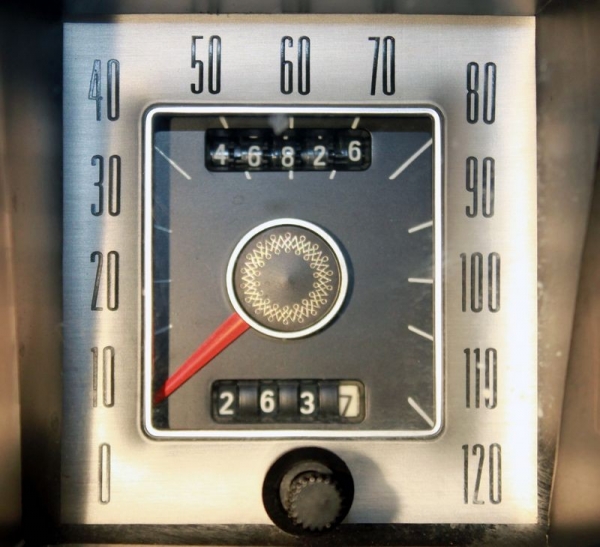
At this years Detail Fest we scheduled 2 Mini-Classes on Machine Polishing Paint which introduced the students to 4 different types of electric polishers. In-between these two classes we opened our Training Garage for people to bring their cars for evaluation and recommendations as to the correct products procedures to restore a show car finish.
Bill heard about our event at a local car show and asked me if I could take a look at his car, once he told me the year of his car I said “yes” as I love working on single stage paint. At that moment in time I didn’t know how much time I would later be investing into his car’s finish to carefully remove the oxidation and restore a show room new, factory finish.
Bill carefully maneuvered his classic American Land Yacht through the crowds of people and pulled it right up to the entrance of our studio and training center. I had him leave it outside in natural light so I could both inspect the paint and take some pictures.
Without further ado, here’s Bills all original 1973 Lincoln Continental with the original, well preserved but extremely oxidized single stage metallic finish.
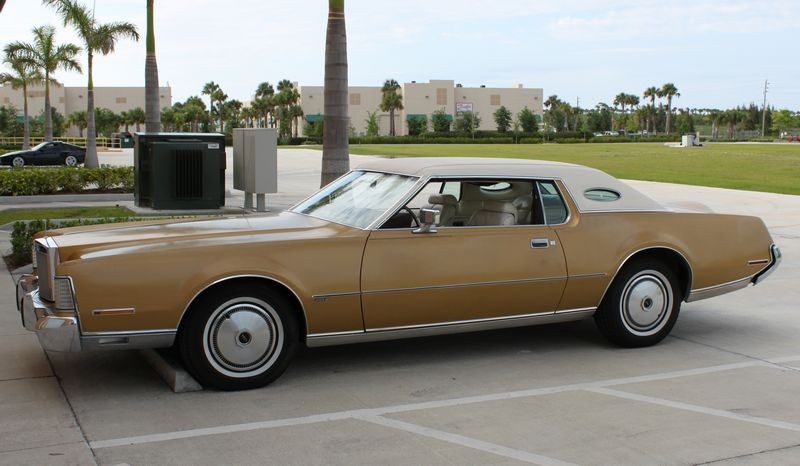


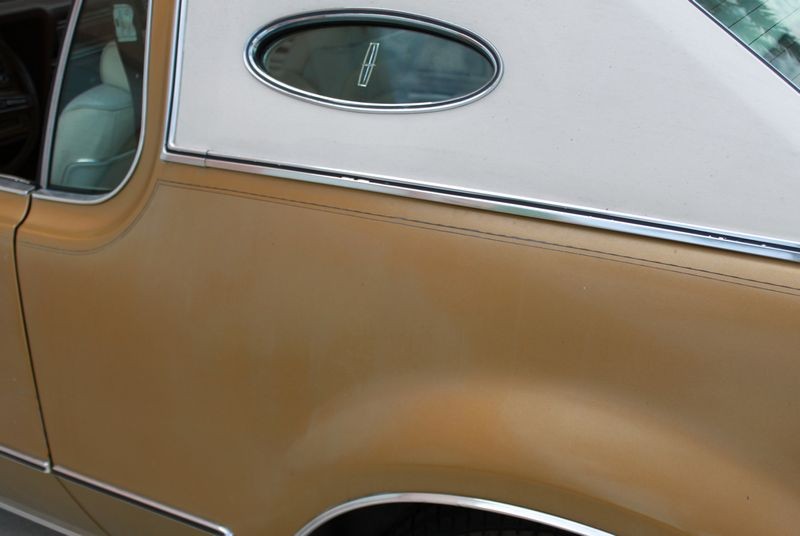

And a few weeks later... here it is ready to have the paint restored...


-
Post Thanks / Like - 1 Thanks, 1 Likes, 0 Dislikes
Similar Threads
-
By Speedviktm in forum Ask your detailing questions!
Replies: 12
Last Post: 03-05-2019, 05:24 PM
-
By 2shiny in forum Ask your detailing questions!
Replies: 7
Last Post: 09-18-2013, 06:52 AM
-
By TwoFoolsAMinute in forum Auto Detailing 101
Replies: 12
Last Post: 11-19-2012, 12:57 PM
-
By Mike Phillips in forum How to articles
Replies: 6
Last Post: 05-01-2012, 08:47 AM
-
By canairb in forum Auto Detailing 101
Replies: 7
Last Post: 08-23-2010, 03:40 PM
 Members who have read this thread: 3
Members who have read this thread: 3
 Posting Permissions
Posting Permissions
- You may not post new threads
- You may not post replies
- You may not post attachments
- You may not edit your posts
-
Forum Rules
|
| S |
M |
T |
W |
T |
F |
S |
| 28 | 29 | 30 |
1
|
2
|
3
|
4
|
|
5
|
6
|
7
|
8
|
9
|
10
|
11
|
|
12
|
13
|
14
|
15
|
16
|
17
|
18
|
|
19
|
20
|
21
|
22
|
23
|
24
|
25
|
|
26
|
27
|
28
|
29
|
30
|
31
| 1 |
|













 Thanks:
Thanks:  Likes:
Likes:  Dislikes:
Dislikes: 
















 Reply With Quote
Reply With Quote
Bookmarks